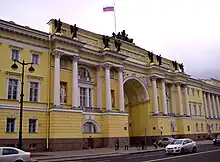Governing Senate
The Governing Senate[lower-alpha 1] was the highest legislative, judicial, and executive body subordinate to the Russian emperors, instituted by Peter the Great to replace the Boyar Duma and lasted until the very end of the Russian Empire. It was chaired by the Procurator General, who served as the link between the sovereign and the Senate; he acted, in the emperor's own words, as "the sovereign's eye".
| Правительствующiй Сенатъ Правительствующий Сенат | |
 | |
 Senate and Synod Building on Senate Square, Saint Petersburg | |
| Agency overview | |
|---|---|
| Formed | 1711 |
| Dissolved | 1917 |
| Headquarters | Saint Petersburg |
Description
Originally established only for the time of Peter's absence, it became a permanent body after his return. The number of senators was first set at nine and, in 1712, increased to ten. Any disagreements between the Chief Procurator and the Senate were to be settled by the monarch. Certain other officials and a chancellery were also attached to the Senate. While it underwent many subsequent changes, it became one of the most important institutions of imperial Russia, especially for administration and law.
The State Council, created by Alexander I, was supposed to inherit the executive power of the Senate. An envisioned parliament was to inherit legislative power, but that never happened.
In the 19th century, the Senate evolved into the highest judicial body in Russia. As such, it exercised control over all legal institutions and officials throughout the country.
The Senate was composed of several departments, two of which were Courts of Cassation (one for criminal cases, one for civil cases). It also included a Department of Heraldry, which managed matters relating to the rights of the nobles and honorary citizens.
First nine senators
Count Ivan Musin-Pushkin, Boyar Tikhon Streshnev, Prince Petr Golitsyn, Prince Mikhail Dolgorukov, Grigoriy Plemiannikov, Prince Grigoriy Volkonskiy, General Mikhail Samarin, Quartermaster general Vasiliy Apukhtin и Nazariy Melnitskiy. As an ober-secretary was appointed Anisim Schukin.[1][2]
Procurator Generals
- 1722 - 1735 Pavel Yaguzhinsky
- 1740 - 1760 Nikita Trubetskoy
- 1760 - 1761 Yakov Shakhovskoy
- 1761 - 1764 Aleksandr Glebov
- 1764 - 1792 Aleksandr Vyazemsky
- 1792 - 1796 Alexander Samoylov
- 1796 - 1798 Aleksei Kurakin
- 1798 - 1799 Pyotr Lopukhin
- 1799 - 1800 Aleksandr Bekleshov
- 1800 - 1801 Pyotr Obolianinov
Procurator Generals and Ministers of Justice
- 1802 - 1803 Gavrila Derzhavin
- 1803 - 1810 Pyotr Lopukhin
- 1810 - 1814 Ivan Dmitriev
- 1814 - 1817 Dmitriy Troshchinsky
- 1817 - 1827 Dmitry Lobanov-Rostovsky
- 1827 - 1829 Aleksei Dolgorukov
- 1829 - 1839 Dmitriy Dashkov
- 1839 Dmitry Bludov
- 1839 - 1862 Viktor Panin
- 1862 - 1867 Dmitriy Zamyatnin
- 1867 Sergei Urusov
- 1867 - 1878 Konstantin von Pahlen
- 1878 - 1885 Dmitry Nabokov
- 1885 - 1894 Nikolay Manasein
- 1894 - 1905 Nikolay Muravyov
- 1905 Sergey Manukhin
- 1905 - 1906 Mikhail Akimov
- 1906 - 1915 Ivan Shcheglovitov
- 1915 - 1916 Alexander Khvostov
- 1916 Alexander Makarov
- 1916 - 1917 Nikolay Dobrovolsky
See also
- Pruth River Campaign (1710—1711)
Sources and references
- Steinberg, Mark D.; Riasanovsky, Nicholas Valentine (2005). A History of Russia. Oxford [Oxfordshire]: Oxford University Press. ISBN 0-19-515394-4.
References
- "On 5 March 1711 according to the Peter I ukase in Russia was established the Governing Senate". This day in history. Presidential Library. Archived from the original on 2018-08-15. Retrieved 2018-11-14.
- "The Ukase about creation of the Governing Senate and its individual composition". Сайт Конституции Российской Федерации. Archived from the original on 2020-01-16. Retrieved 2020-01-16.